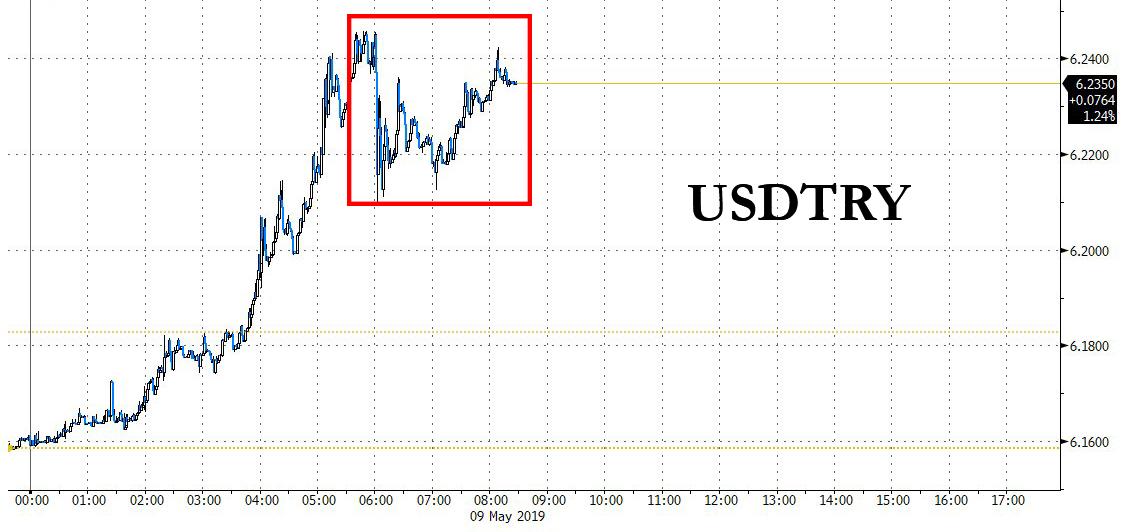Fra Zerohedge:
Turkey’s economic and currency implosion is getting worse by the day.
With investors increasingly concerned about Turkey’s level of FX reserves and ability to defend the currency, on Wednesday ABN-Amro analyst Nora Neuteboom poured gasoline on the fire saying what everyone else already knows, namely that “given the relatively low reserves, Turkey cannot afford to deplete its reserves further by defending the currency,” adding that “as investors are well aware of this fact, a little spark in, for example the tensions with the U.S., could easily trigger another lira sell-off.”
Of course, with the Turkish lira already in freefall, we may not even need a spark, as the rout gets worse with every passing day.
To wit: on Thursday, the lira fell for a fifth day against the dollar, touching the lowest level in eight months as investors bid up the price of Turkish CDS which insure against a default on the nation’s bonds. The lira weakened as much as 1% to 6.2456, sliding below 7 per euro, while the cost of five-year credit default swaps climbed above 490bps for the first time since September.
The lira – which Bloomberg reminds us has been the worst-performing currency in the world this quarter – shed more than 4% of its value over the past five trading sessions amid the fallout from Turkey’s decision to re-run municipal elections in Istanbul.
And then, out of the blue, an unexpected attempt to restore confidence in the lira took place, when just after 6am ET, Turkey’s central bank unexpectedly raised borrowing costs for the country’s lenders on Thursday in an attempt to bolster the crashing currency. The decision effectively raised the cost of funding for banks by 150 basis points without an official increase in its benchmark interest rate, with the central bank explaining in a statement that the decision was due to volatility in financial markets.
What happened next? Well, there was good news and bad news.
First the good news: moments after the central bank announced it was suspending one-week repo auctions once again, ceasing to provide liquidity to lenders at its cheapest rate of 24%, and effectively requiring banks to obtain their Central Bank funding at the overnight lending window at an interest rate of 25.5%, 150bp above the repo rate, the lira initially trimmed losses, with the USDTRY sliding as much as 300 pips.
In the press release, the Bank noted: “Considering the developments in financial markets, it has been decided to suspend the one-week repo auctions for a period of time.”
Immediately, however, the skeptics emerged: “It is an attempt to slow down the rapid ascent of the dollar-lira pair,” Rabobank’s Piotr Matys said. “But it will not change the underlying upside bias supported mostly by domestic factors – mainly political risk – with additional support coming from the negative external backdrop.”
Commenting on the move, Bloomberg economist Ziad Daoud agreed that the move would be futile, and at worst, accelerate the drop in the lira: “the tightening of monetary policy through the suspension of the one-week repo auction is unlikely to stem the decline in the lira – the problems today are more political than economic. And low interest rates on bank deposits limit the effectiveness of any hikes by the central bank.”
As a reminder, the TCMB stopped one-week repo funding on March 22 but restarted on April 8. Given that the tightening is not done through the main policy rate but through shifting the funding to a different window, such a move was destined to “not be very effective as it seems to signal that this tightening is only temporary” according to Goldman, which adds that “shifting the funding window frequently rather than adjusting the main policy rate could undermine the effectiveness of monetary policy.”
Well, for once Goldman was right, which also brings us to the bad news: not even two hours after the emergency central bank intervention, the attempt to restore confidence in the lira fizzled, as sellers returned in full force and sent the USDTRY back to where it was just before the central bank’s suspension of the one-week repo auction…
… confirming that the market is no longer afraid of any central bank actions, unexpected or otherwise.
Discussing what Turkey should do, Goldman FX startegists write that “the authorities will ultimately need to let the domestic financial conditions tighten and signal this by raising the main policy rate, with the size of the hike needed depending on the extent of its transmission to other rates in the economy, in particular domestic deposits rates.”
In our view, the TRY has recently been under pressure mostly due to the fall in local money demand that manifests itself in an increasingly dollarising deposit base; hence, higher deposit rates will be needed to safeguard financial stability.
There is just one problem with that prescription: just like Trump, Erdogan loathes higher rates. In fact, he recently hinted that it may be time for a rate cut. And sure, while the central bank may hike overnight rates to 1000%+ again, or even hike rates briefly, all that would lead to is an even faster collapse in the economy which is now Erdogan’s personal fiefdom, as not even an IMF bailout would be allowed as long as the Turkish “executive president” is in charge.
Which begs the question: with the lira be the first true “western” currency casualty? With the country’s reserves almost gone, we won’t have long to wait to find out








